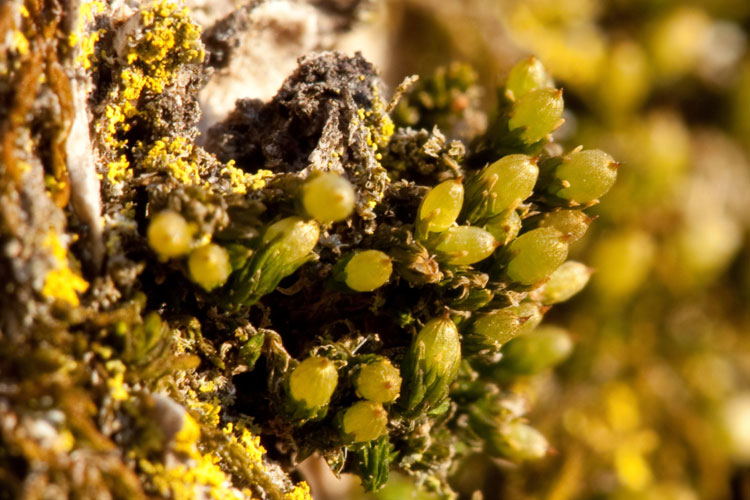 |
 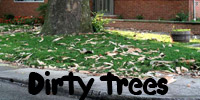 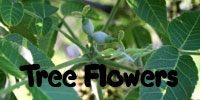 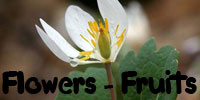 |
Welcome
to bobklips.com, the website of Bob Klips, a plant enthusiast living in
Columbus, Ohio.
Rose sedge, Carex rosea (Cyperaceae, the sedge family) is a common woodland plant, seen here in a rich forest adjacent to the Scioto River in Delaware County, Ohio. Distinctive features include the widely spaced groups of fruits (spikelets), the broad-based, biconvex shape of the individual fruits (actually, its the shape of the "perigynia," i.e., the bag-like envelopes surrounding each single-seeded fruit), and the roughness of the perigynium-beak. 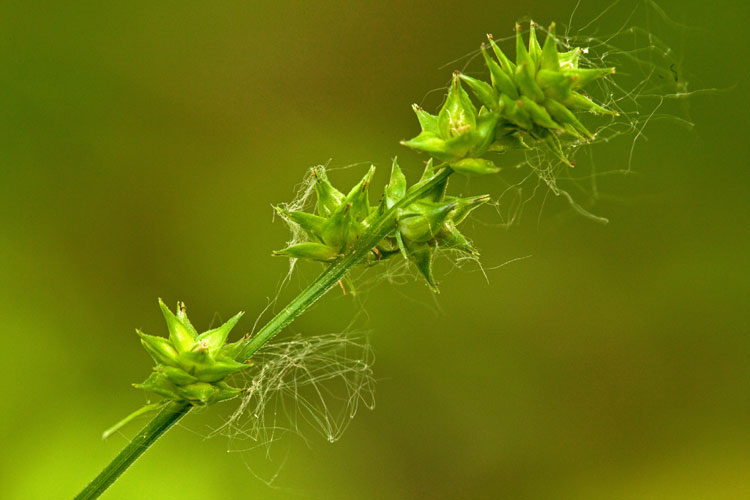 Rose sedge. Delaware County, Ohio. May 20, 2010. A month earlier when this
sedge was in flower, I took a flash photograph, and today I snapped a
companion flash picture. (Note the dreaded black background.)
Individual Carex flowers are
unisexual. The manner in which thay are arranged relative to one
another
is a useful identification feature. Here, the spikelets contain both
types of flowers, with the pistillate
(female) ones at the base of each spikelet and a few staminate (male)
ones at the tip.
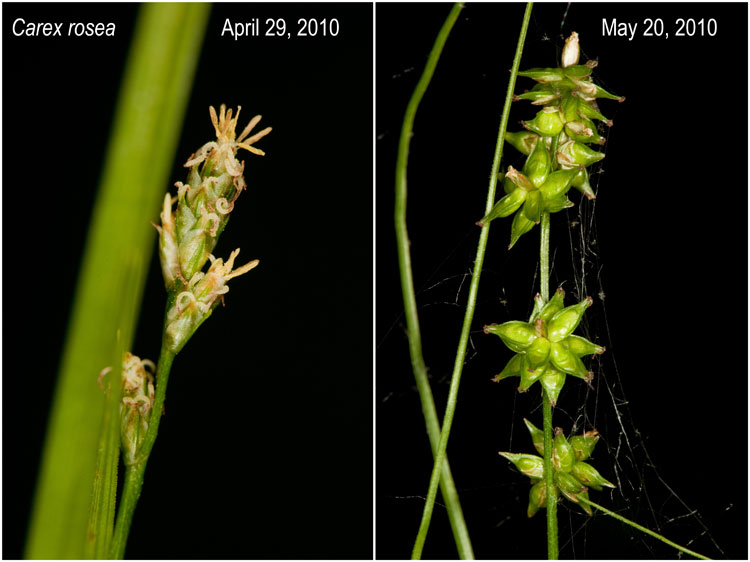 Rose sedge in flower and fruit, one month apart. Delaware County, Ohio. A rich woods along the Scioto
River in Delaware County, Ohio is home to a pair of waterleaf species,
genus Hydrophyllum in the
Boraginaceae (borage family). (Note: waterleafs and a few other
genera lacking the very deeply 4-lobed ovaries that characterize most
members of the borage family, were formerly placed in their own family,
Hydrophyllaceae.) These are
bristly perennial woodland herbs with lobed leaves and coiled cymes of
white or blue flowers that have 5 fused sepals and 5 fused petals.
Waterleafs are named for their mottled leaves, giving the appearance of
having water spots. Here's a picture of a waterleaf leaf taken a few
years ago in Marion County, Ohio.
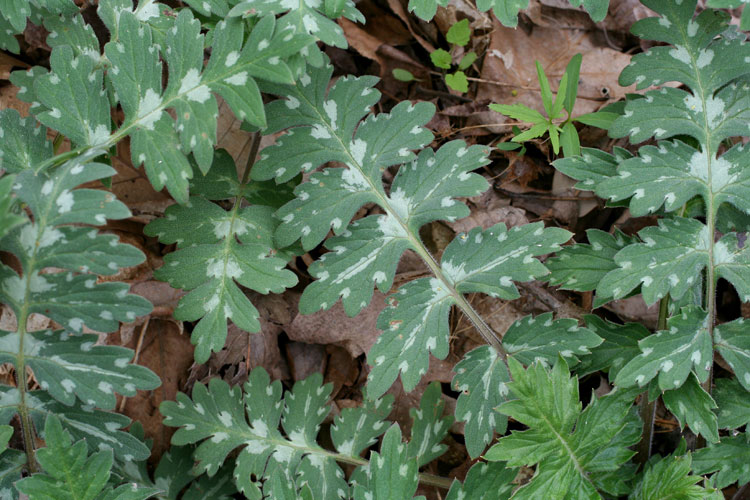 Waterleaf leaf showing "water spots." April 20, 2006. Marion, Ohio. We have four Hydrophyllum species in eastern
North America, all of which occur in Ohio. The species are
distinguished by their leaves (pinnately divided versus palmately
divided) and their peduncles and pedicels (glabrous versus pubescent).
One of the wateleafs flowering here today is "appendaged waterleaf," H. appendiculatum, which combines
palmately lobed leaves with densely pubescent peduncles and pedicels.
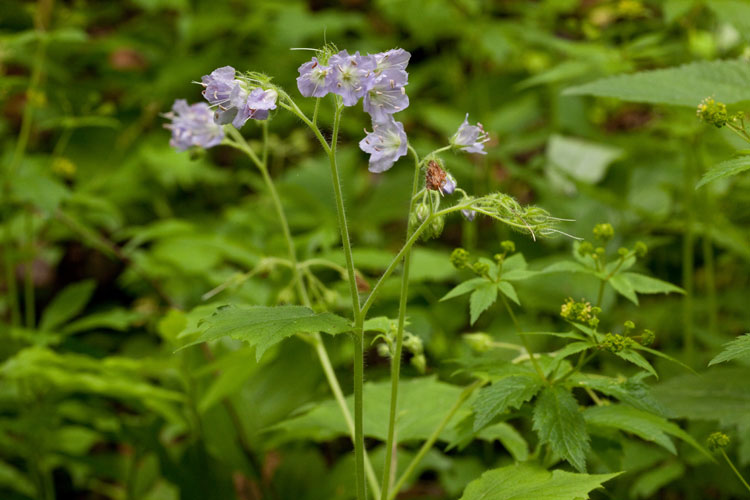 Appendaged waterleaf. May 19, 2010. Delaware County, Ohio. Waterleaf flowers are folded
(imbricate) in the bud. The corolla-lobes wide-spreading; the
stamens are long-exsert.
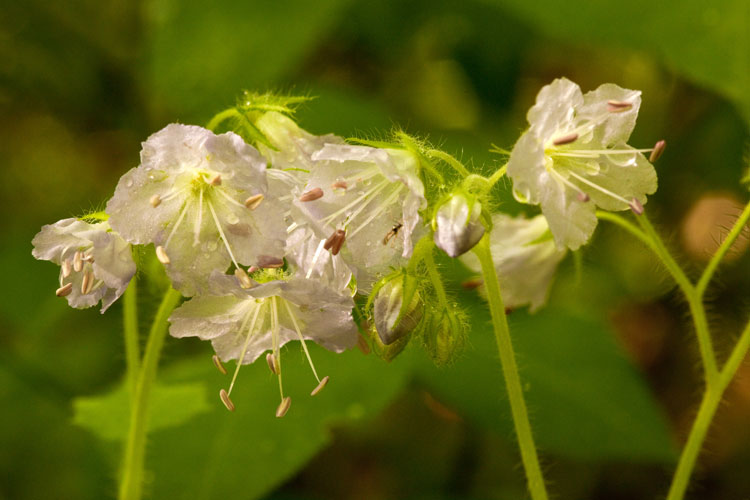 Appendaged waterleaf flowers. May 19, 2010. Delaware County, Ohio. Here a bee and a flower
longhorn beetle occupy adjacent flowers of appendaged waterleaf. Flower
longhorn beetles are day-active insects that feed on pollen. They have
a distinctive shape, being broad-"shouldered" and tapered toward both
the
head and the rear.
Bee and beetle on waterleaf
flowers in Delaware County, Ohio. May 19, 2010.
Large-leaved waterleaf, H.macrophyllum
also occurs here.
This species is a bit shorter and coarser than appendaged
waterleaf, and its flowers are white, and more deeply lobed. The
blossom
on the right displays clearly its single style, shortly bifid at the
summit, positioned at the same level as the stamens.
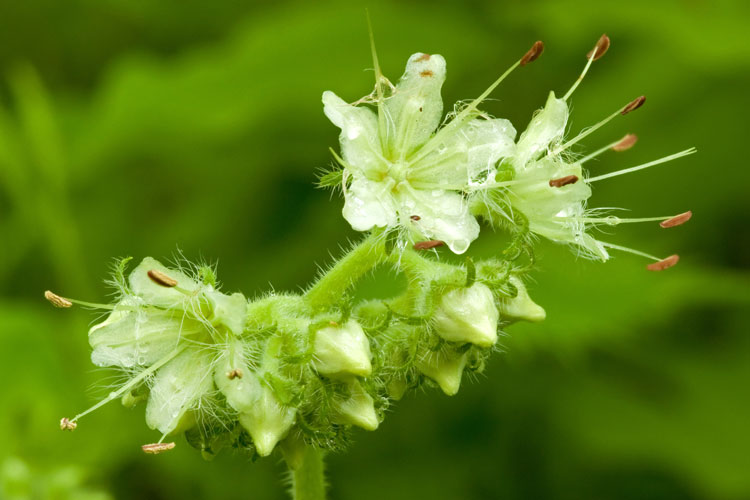 Large-leaved waterleaf flowers. May 19, 2010. Delaware County, Ohio. Yuck. There's a Fly on
my Salad!
(Corn Salad, Valerianella umbilicata) Delaware County, Ohio. May 19, 2010. The plant called "beaked corn
salad" (a.k.a., "lamb's lettuce, and it yes, it actually is edible), Valerianella umbilicata
(Valerienaceae, the valerian family) is a very abundant native annual
that occurs in open spots in woods, along streambanks, in moist
meadows, and roadsides. One of only two Ohio genera in its family (the
other is Valeriana, described
below at Deep Woods), Valerianella
is distinguished by its leaves: simple and unlobed.
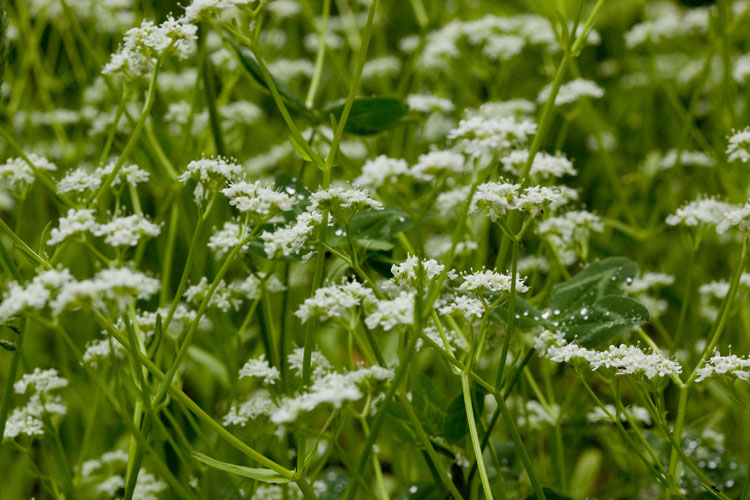 Roadside riot of corn-salad. May 19. Delaware County, Ohio. Corn-salad flowers are small,
displayed in flat-topped compound clusters called "cymes." They are
radially symmetric, small, and funnel-shaped, with 5 fussed petals and
three (!) stamens.
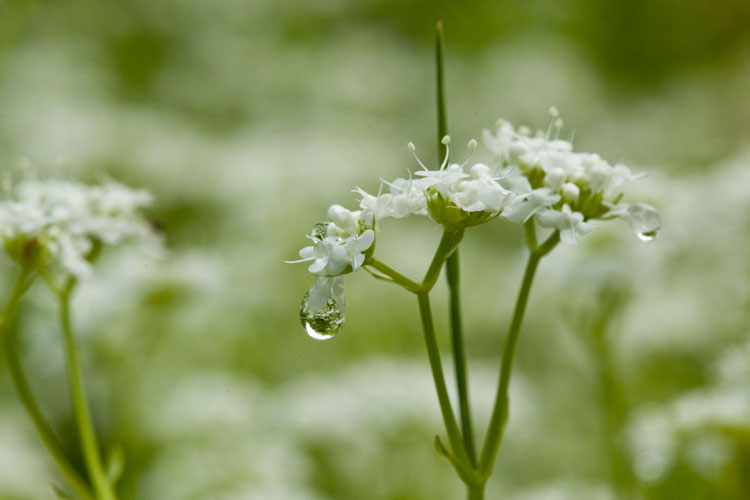 Beaked corn-salad. May 19, 2010. Delaware County, Ohio. Corn-salad is edible; just
snap it off and munch. But not this one, yuck! There's a fly on it!
Looking on the bright side, however, it appears as though the fly could
be a pollinator. The fly's body is indeed dusted with white pollen
grains, and the sexual parts of the flowers seem very well oriented to
have the fly transfer the grains; note the anther pressed against the
abdomen, and see elsewhere each flower's single style at about the same
height.
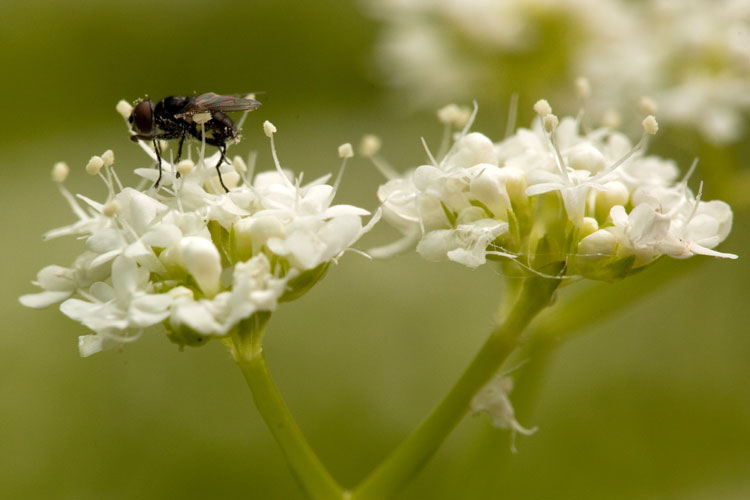 A fly visits beaked corn-salad. May 19, 2010. Delaware County, Ohio. Here's the motion picture.
Fly, possible pollinator, visits beaked corn-salad in Delaware County, Ohio. Sedges are found mainly in moist to wet natural areas, but a few intrepid species manage to occur in the city. Pale sedge, Carex blanda is one such sedge. It's in section Laxiflorae, the "loose-flowered woodland sedges." Their flowers are borne in short cylindric unisexual spikes; the terminal one is wholly staminate. Their flowers bear 3 stigmas and develop into trigonous achenes. They have fairly wide leaves with a somewhat loose-fitting sheath. The perigynia are beakless, or very short-beaked. Pale sedge spikes are more densely-flowerd that many members of the section. The perigynia are very plump. Carex blanda is the most common member of sect. laxiflorae, often locally abundant, and capable of being somewhat weedy. 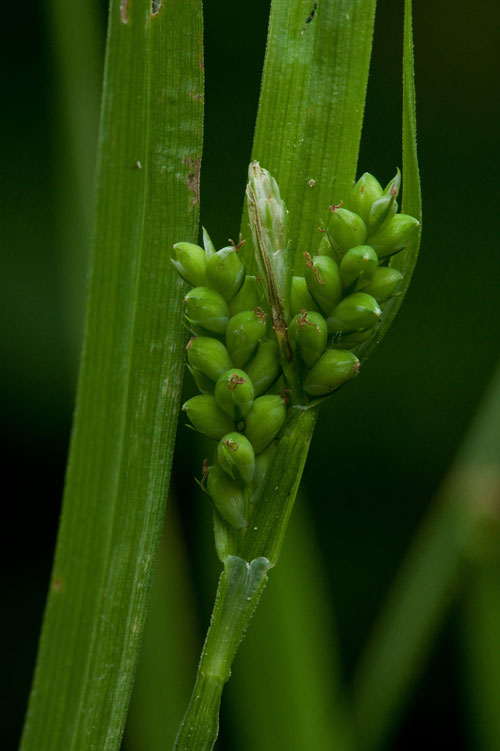 Pale sedge. Columbus, Ohio. May 16, 2010. The owners of Deep Woods, a
private nature preserve in Hocking County, Ohio, held a well-attended
and enjoyable work weekend to perform some important maintenance:
putting up an interpretive sign, framing a doorway, replacing bridge
slats, etc., etc. Here are some of the workers making improvements to a
wildlife observation shelter. One of the workers is me, who,
immediately after this picture was taken, snuck off to take pictures of
plants, and was never seen again holding a hammer or a saw.
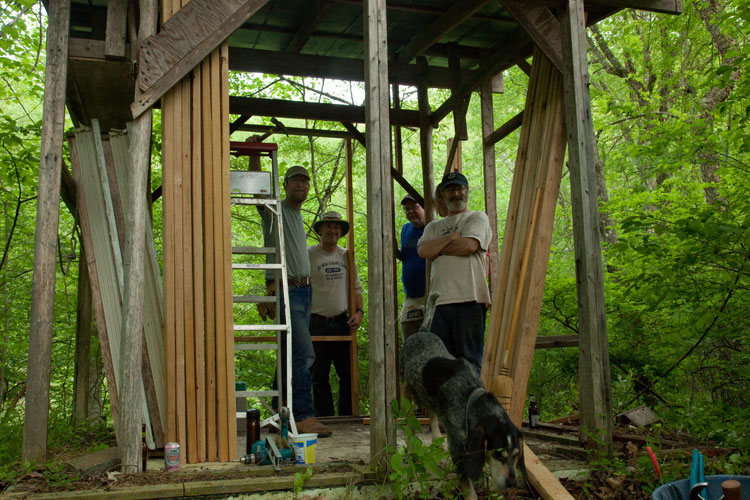 Deep Woods work day workers. May 15, 2010. Hocking County, Ohio. It was the call of the sedge
that drew me away. There's a lot of interest in sedges nowadays. Sedges
are members of the family Cyperaceae. With 243 species in Ohio, it's
our biggest family, and, with its 163 Ohio species, the genus Carex is especially prominent.
Many carices (yes, that's the word for more than one Carex) are evident today.
A particularly handsome sedge is eastern narrow-leaved sedge, Carex amphibola. This sedge bears separate male (staminate) and female (pistillate) spikes. The terminal spike is entirely staminate. 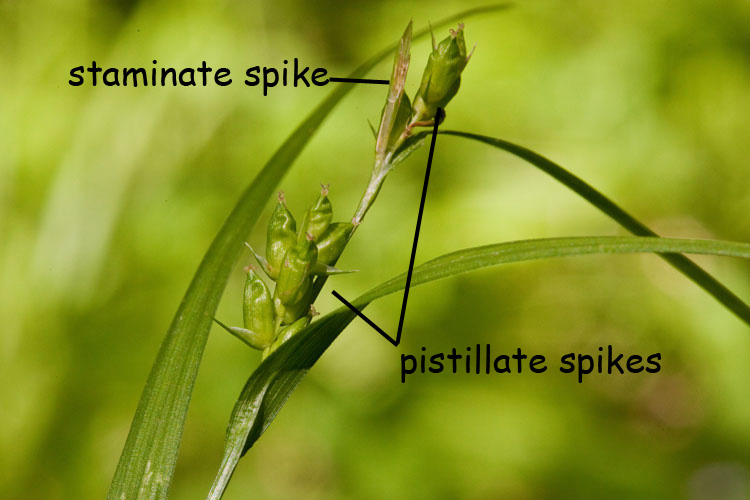 Carex amphibola at Deep Woods Preserve, Hockoing County, Ohio. May 15, 2010. The distingushing feature of Carex
is the "perigynium." This is a bag-like envelope surrounding each
miniscule female flower through which the styles protrude. It persists,
surrounding the fruit, a one-seeded "achene." Here's a studio shot of C. amphibola,
showing its obtusely triangular in cross-section perigynia, one of
which with is sliced open to expose the achene. Note also the little
leaf-like appendage beneath each perigynium, the "pistillate scale,"
which is useful in distinguishing species. For instance, here the
midevein of each scale is prolonged, forming a rough narrow awn that
extends far beyond the body of the scale.
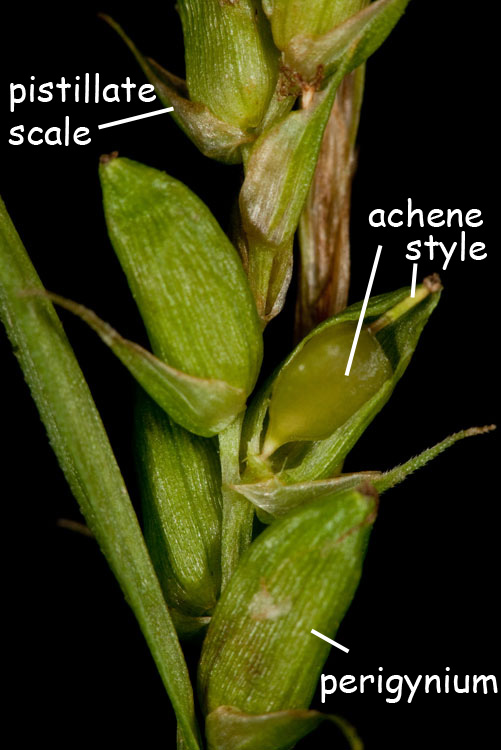 Carex amphibola from Deep Woods. May 15, 2010. Growing nearby is a similar,
and closely related plant, narrow-leaved sedge, Carex grisea.
It is distinguished from C. amphibola by the proportion of its
perigynia --smaller, more pointed, and circular (not triangular) in
cross-section.
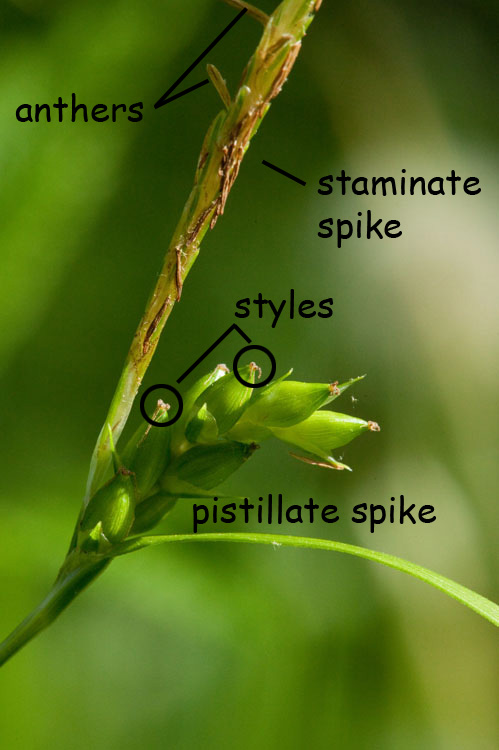 Carex grisea at Deep Woods. May 15, 2010. Graceful sedge, Carex gracillima,
bears long narrow spikes on slender peduncles. Male flowers are located
at the base of the terminal spike, which also bears fruit.
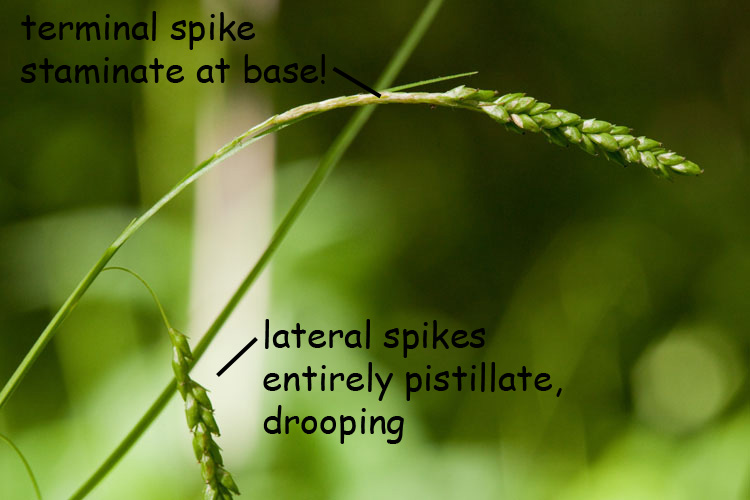 Carex gracillima. Deep Woods Preserve. Hocking County, Ohio. May 15, 2010. All of the sedges shown so far have a feature in common: the female flowers have three stigmas, and the resultant achene is correspondingly 3-angled. A whole bunch of other Carex sedges have two stigmas, and bear more or less flattened 2-sided achenes. Fox sedge, Carex vulpinoidea, produces a complex inflorescence consisiting of several bundles of short spikes, each of which is mostly pistillate, but tipped with a few staminate flowers. The perigynia are about 1/3 filles with spongy tissue surrounding the lower portion of the achene. 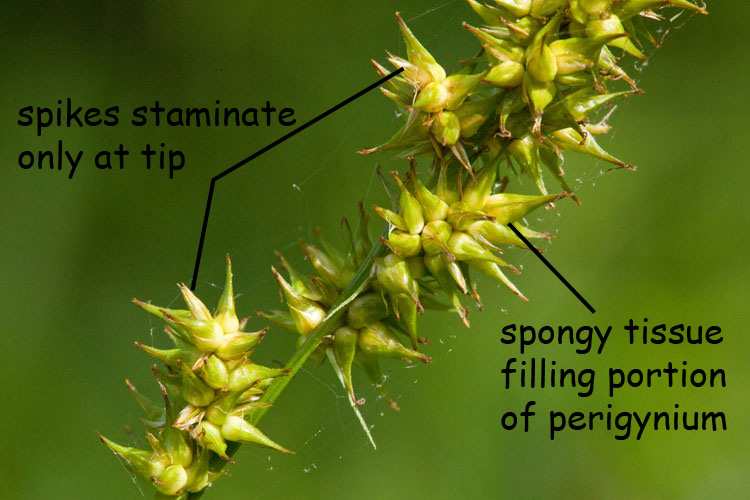 Carex vulpinoidea at Deep Woods, Hocking County, Ohio. May 15, 2010. Another 2-styled, flattened
achene sedge is crested sedge, Carex
cristatella.
With its widely spreading perigynia and globose spikes, this is perhaps
the only easily recognized member of a very confusing group, the
section Ovales.
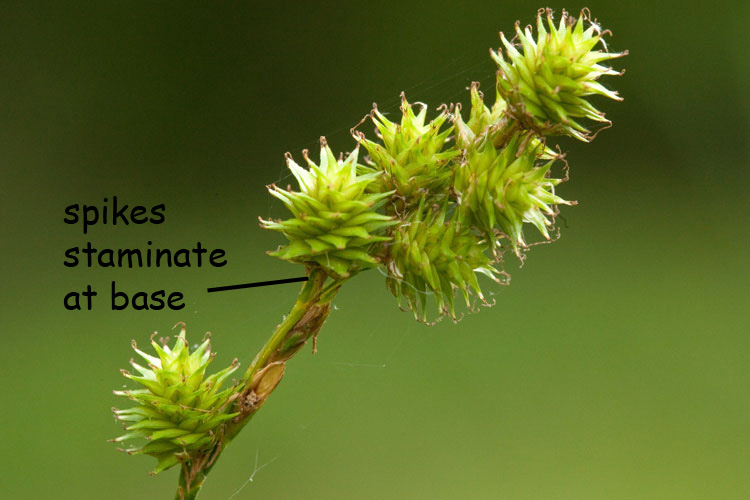 Carex cristatella at Deep Woods, Hocking County, Ohio. May 15, 2010. Thare are some other plants
flowering besides sedges. Here's one, literally beside a sedge (see Carex gracillima in the fuzzy
background); it's large-flowered valerian, Valeriana pauciflora
(Valerianaceae). The valerian family is a fairly small one represented
in Ohio by only two genera. (The other is Valerianella,
corn-salad.) They are opposite-leaved herbs with radially symmetric
flowers with 5 fused petals, and an inferior ovary. Valerian bears
compound leaves.
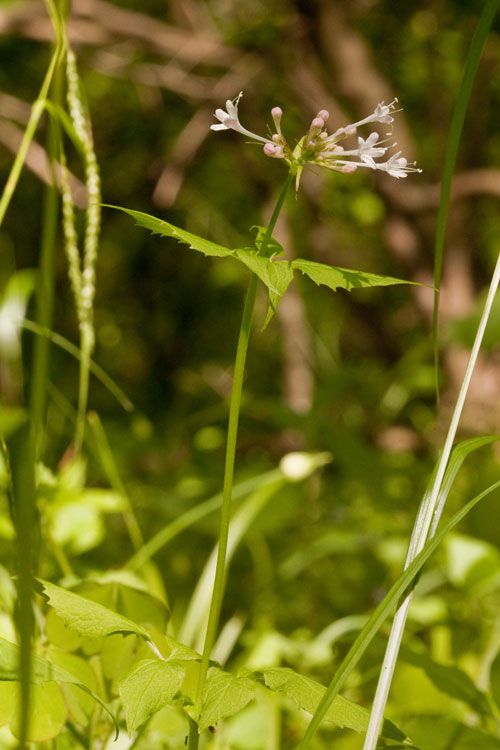 Large-flowered valerian at Deep Woods, Hocking County, Ohio. May 15, 2010. Valerian flowers are
funnel-shaped, with three stamens (that's peculiar!) attached to the
corolla-tube.
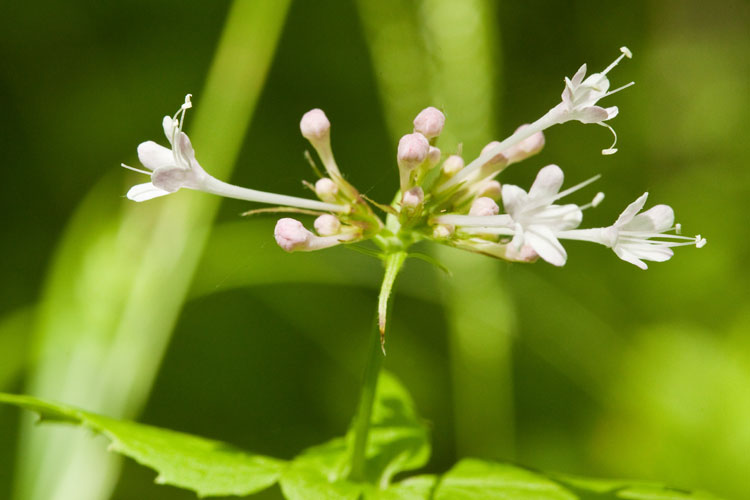 Large-flowered valerian. Deep Woods, Hocking County, Ohio. May 15, 2010. Although great rhodendron,
Rhododendron maximum (Ericaceae, the heath family) is native to Hocking
County (and a few other counties in soutern Ohio), this specimen is
probably a cultivated one, planted a long time ago.
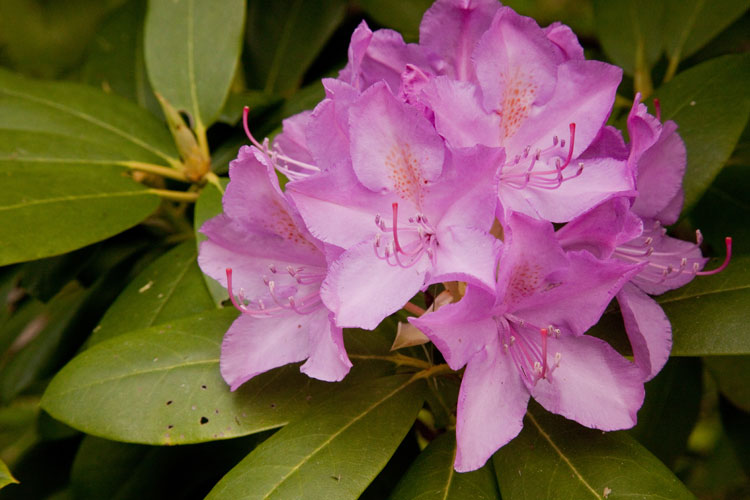 Ornamantal great rhododendron. Deep Woods. May 15, 2010. The Ericaceae is a mainly
artic and temperate family consisting primarily of trees and shrubs,
often associated with acid soil. This Rhododendron, and also Kalmia
(mountain-laurel, also in the Ericaceae) are unique members of our
flora, our only native broad-leaved evergreen shrubs. An intriguing
detail of the flowers are the anthers --they open by terminal pores.
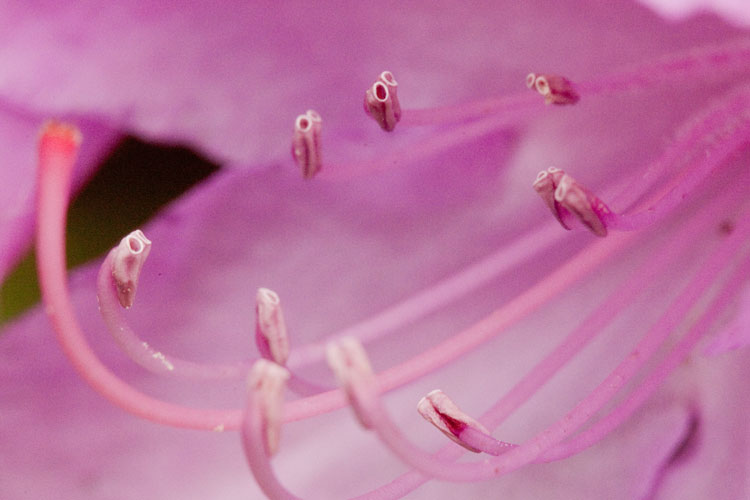 Rhododendron anthers open by terminal pores. Side-by-side in an open
meadow, common dandelion, Taraxacum
officinale
(Asteraceae) in flower and in fruit. In typical Asteraceae fashion,
what seems like an indvidual blossom is actually a tight head-like
cluster of very small flowers called a "capitulum." It develops
into a head like cluster of individual one-seeded fruits called
"achenes," each tipped by a highly modified sepal-derived
parachute-like structure, the "pappus," that facilitates dispersal.
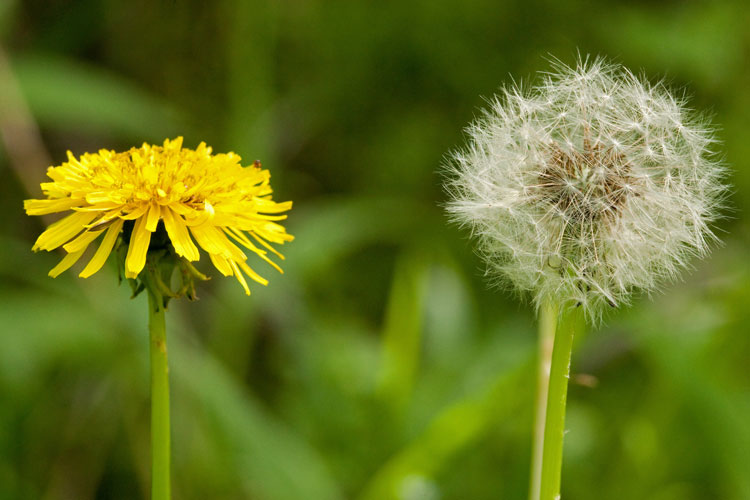 Common dandelion at Deep Woods. May 15, 2010. The pink family,
Caryophyllaceae, consists of opposite-leaved herbs with swollen nodes,
radially symmetric flowers with 5 sepals, 5 separate petals, and an
ovary that develops into a many-seeed capsule opening by teeth or
valves. We have 6 species in the chickweed/stitchwort genus Stellaria, four of which are alien.
This is one of them, common stitchwort, S. graminea. Note the petals, each
deeply 2-cleft, giving the appearance of a 10-petaled flower.
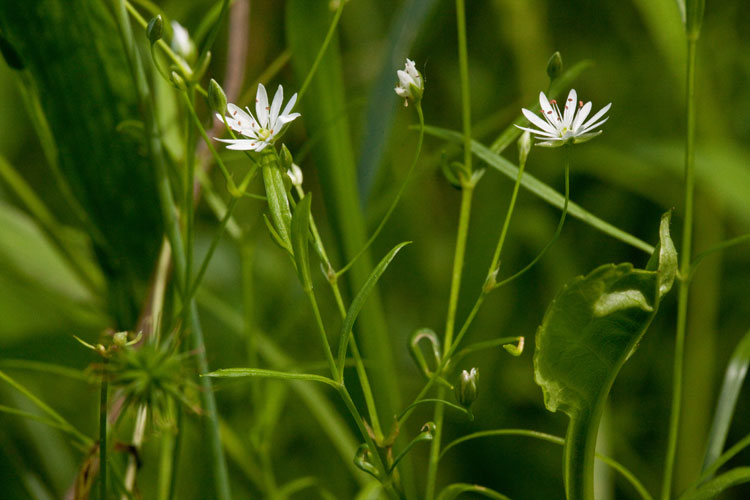 Common stitchwort at Deep Woods Preserve. Hocking County, Ohio. May 15, 2010. In the
development of
evolutionary theory, French naturalist Jean Baptiste Lamarck was one of
the first to set forth a mechanism to account for change in the form of
organisms over time. Lamarck's "inheritance of acquired
characteristics" posited that over an organism's lifetime, depending
upon what that organism did, certain body parts would become
strengthened or increased, and, moreover, that this increase in size,
strength, etc., would be passed along to its offspring. The only thing
wrong with Lamarck's theory was that it was wrong! We now know that
genes, not what an organism does during its lifetime, determine the
traits of offspring. Evolution is best explained by
Darwin's theory of natural selection, which recognizes that individuals
differ in heritable traits that influence survival
and reproduction, and that those organisms best adapted to the
environment will pass their genes for those traits on to their
offspring.
Perhaps the distinction between the two views is best depicted graphically. [Note: the "Professor Klips" (a.k.a. "Dr. Bob") referred to in the cartoon occasionally uses those whatever they're called grabber/snapper/puppet thingeys to illustrate scientific concepts in his introductory biology classes.] 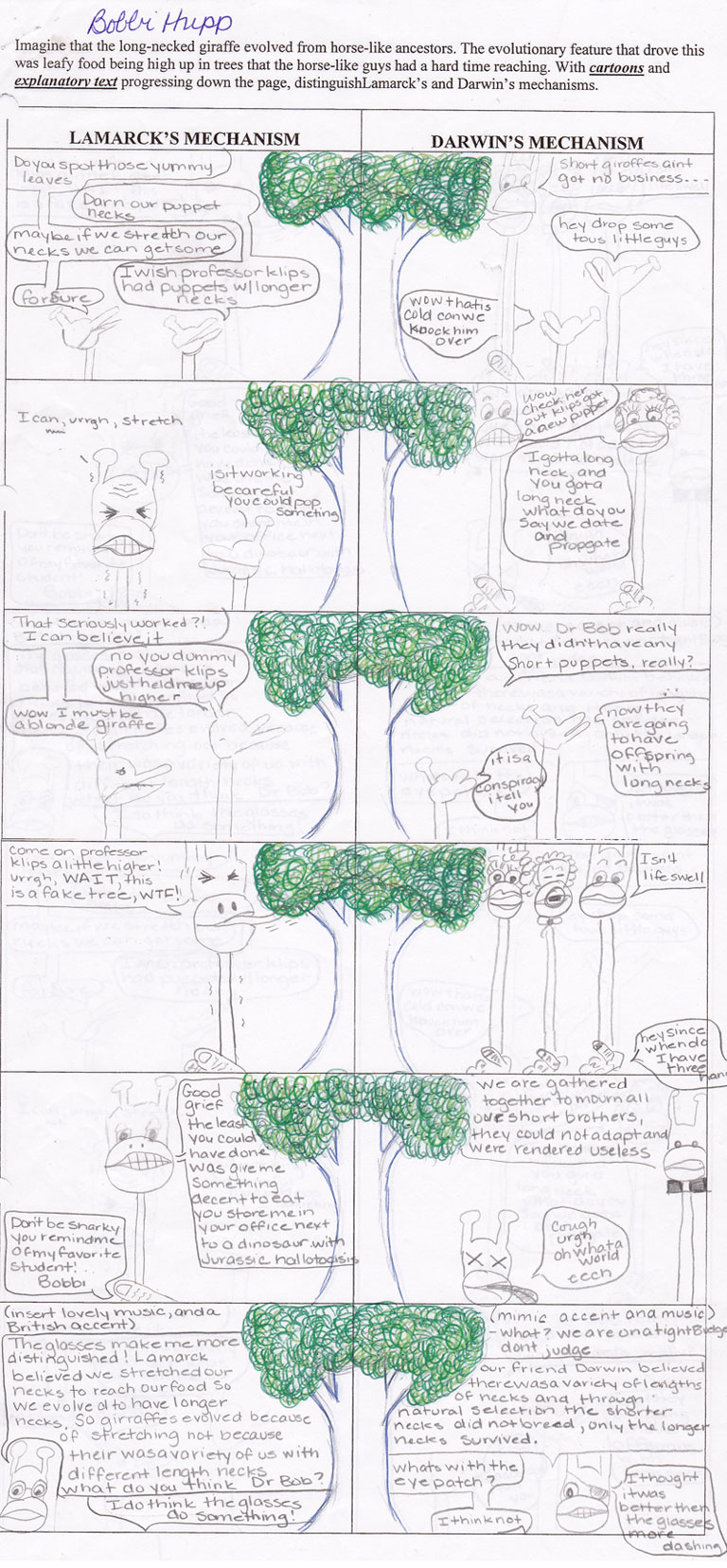 Hickories (genus Carya in the family Juglandaceae, the walnut family), like many forest trees, are monoecious, i.e., having unisexual (separate male and female) flowers, but with both types together on each tree. Being wind-pollinated, hickories produce inconspicuous flowers lacking the showy petals needed by some plants to attract pollinators. The male flowers are both very tiny and very numerous, arranged in drooping spikes called catkins, while the female flowers are few in number and much larger than the male ones. Here's a branch of bitternut hickory (Carya cordiformis) just beginning to flower. Note the staminate (male) catkins are slender, borne in stalked clusters of 3 at the ends of last year's branch. The pistillate flowers are in a short spike of 2 or 3 flowers, terminating the branch. 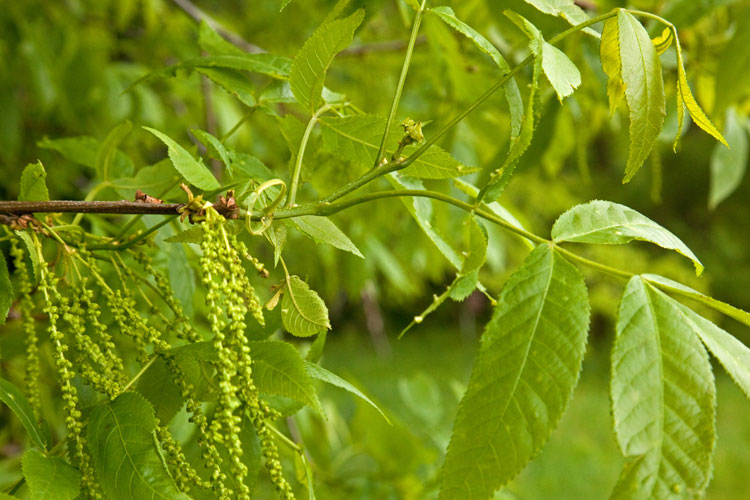 Bitternut hickory flowering branch. May 10, 2010. Terradise Nature Preserve, Marion County, Ohio. The pistillate flowers in
this image are disposed in a spike of three flowers, although the
terminal flower doesn't seem to have developed fully. The ovary is
closely surrounded by four bracts destined to comprise part of the husk
surrounded the nut. Two huge plumose stigmas are perched atop the
flowers, effective recipients of wind-borne pollen.
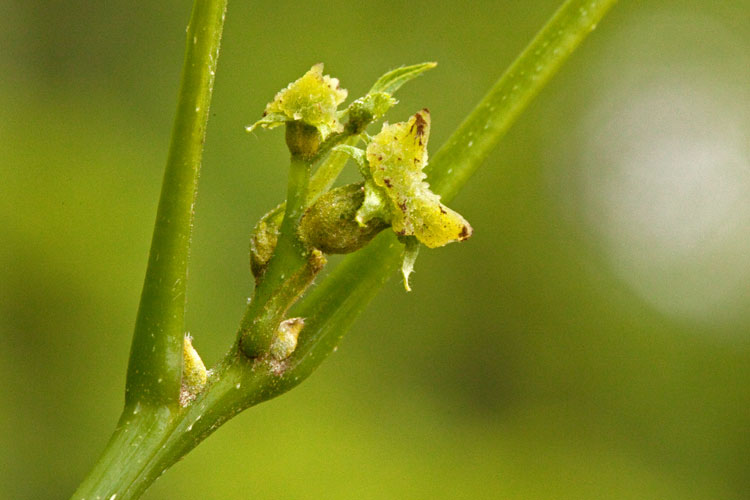 Bitternut hickory female flowers. May 10, 2010. Terradise Nature Preserve. Marion County, Ohio. Members of the parsely family are abundant in many central Ohio woodlands, flourishing after the flush of spring wildflowers. Among them are two species of sweet-cicely, the only members of the genus Osmorhiza that occur in Ohio. These are lacy-leaved, anise-secented forest-floor wildflowers. One is smooth sweet-cicely, O. longistylis, seen at the Terradise Nature Preserve in Caledonia, Marion County, Ohio. 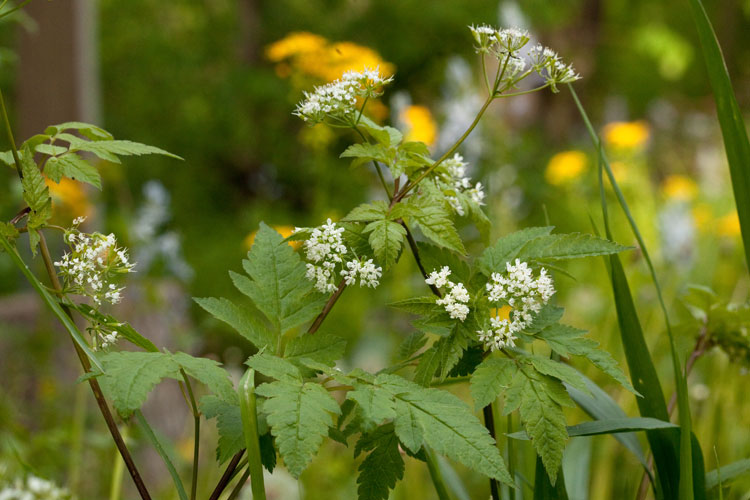 Smooth sweet-cicely. Terradise Nature Preserve, Marion County, Ohio. May 10, 2010. In typical Apiaceae fashion, the flowers of sweet-cicely are individually long-stalked, arranged in compound umbels, wherein several flowers are attached at a single point forming an "umbellet." The umbellets, similarly bundled, constitute the umbel. The photo below features one umbellet, and it displays an interesting feature of the breeeding system of Osmorhiza. The flowers are of two types, about equally represented within each umbellet: (1) slender-stalked "sterile" ones that are male (staminate), and (2) female (pistillate) "fertile" flowers having a prominent ovary and associated structures. I don't know whether the fertile flowers also bore stamens that have since fallen off along with the petals, or they are unisexual. Note as well the diagnostic feature for O. longistylis: the styles are long --about 2mm during anthesis (flowering), extending to 3.5 mm in fruit! 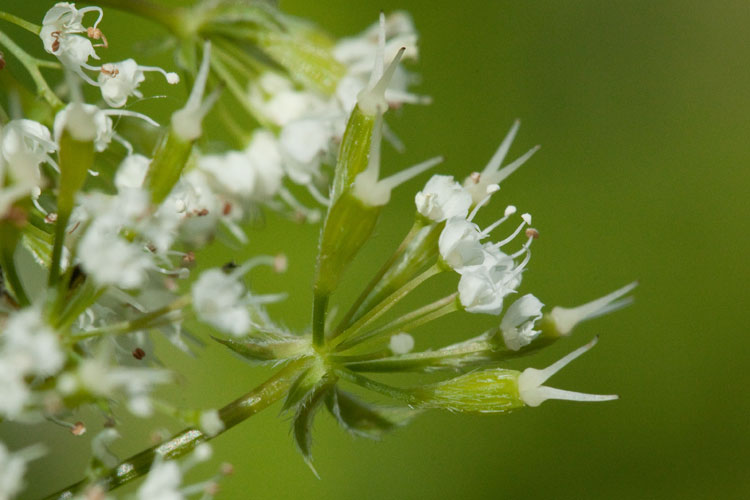 Smooth sweet-cicely umbellet. May 10, 2010. Marion County, Ohio. The Apiaceae fruit is a
special type called a "schizocarp" (translation: "split-fruit"). In
flower, they have an ovary that is 2-chambered, each with a single
ovule (future seed) inside. When the fruit is mature, ready to
disperse its seeds, it splits apart into two single-seeded units called
"mericarps" (happy fish) that mimic the bona fide
1-seeded dry fruit, called an achene. Several popular spices are
apiaceous
mericarps, for example dill "seed." Here's what wooly sweet-cicely
fruits
looked like during midsummer, 2004, on the verge of falling off the
plant, as separate one-seeded units.
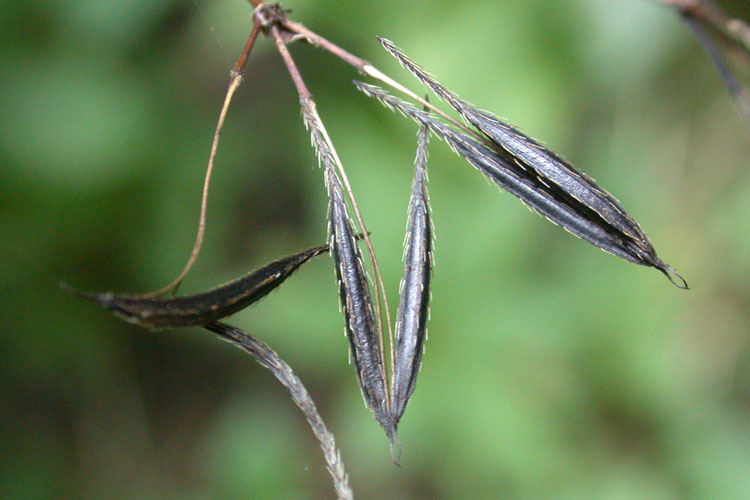 Wooly sweet-cicely. July 21, 2004. Marion County, Ohio. Less than a week later, in a
rich
woodland flanking the Scioto River in Delaware County, the very similar
wooly sweet-cicely, Osmorhiza
claytoni is in bloom.
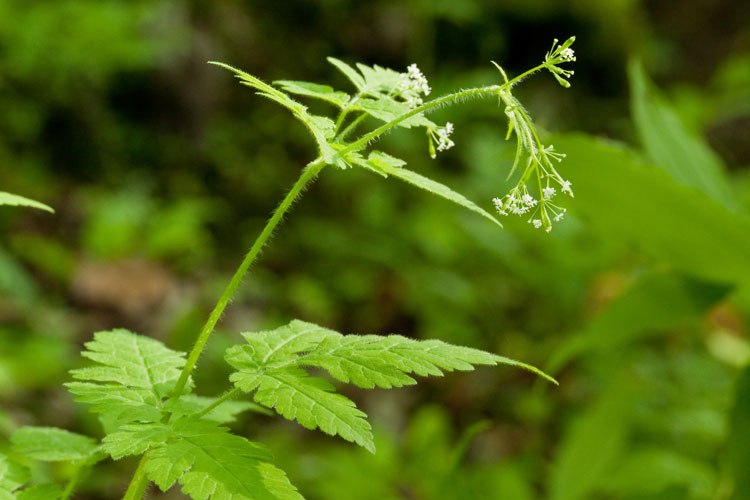 Wooly sweet-cicely. May 15, 2010. Delaware County, Ohio. The styles of this species,
even in fruit, are not more than 1.5 mm long. The picture below shows
flowers and young fruit.
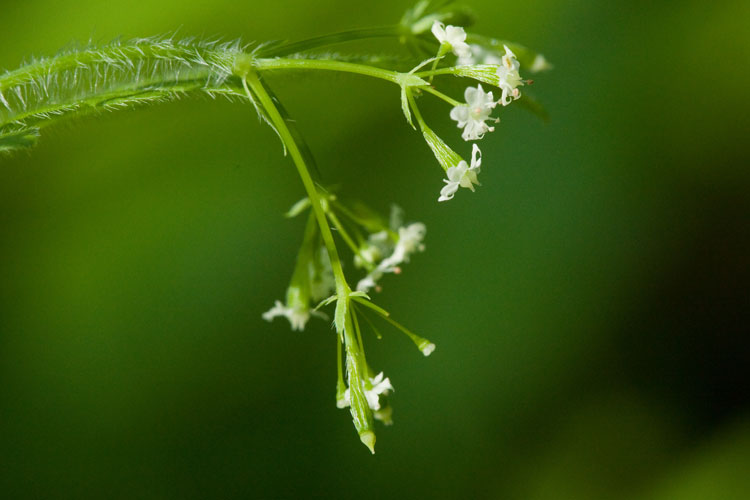 Wooly sweet-cicely. May 15, 2010. Delaware County, Ohio. ...and here at a slightly
later
stage of development, note the staminate flowers have been
shed, leaving only bare remnant pedicels.
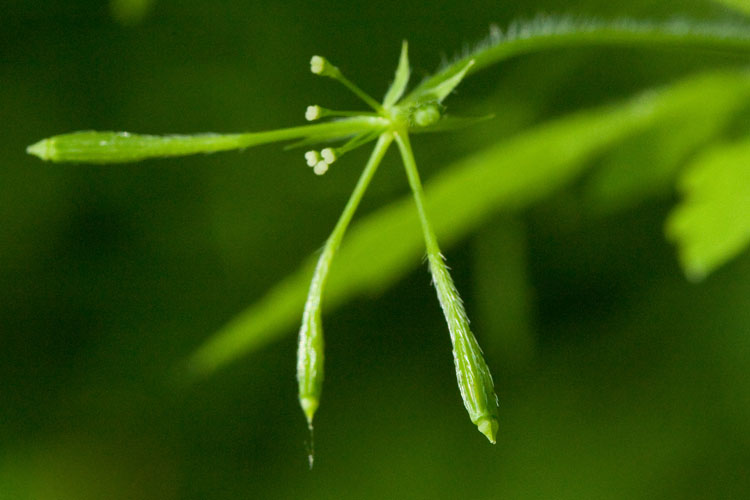 Wooly sweet-cicely young fruit. May 15, 2010. Delaware County, Ohio. Hooded Rosette Lichen at Thew Cemetery Caledonia, Marion County, Ohio. May 7, 2010 One beautiful morning in May
I went on a botanical excursion with a friend, the prominent Marion
County conservationist and history expert, Trella Romine. One of our
stops was a little rural cemetery in Caledonia called Thew Cemetery,
where a few days earlier I had noticed an intriguing lichen on a
headstone (the one seen on the left side of the photo below --the
short-obelisk one with the corrugated-looking base).
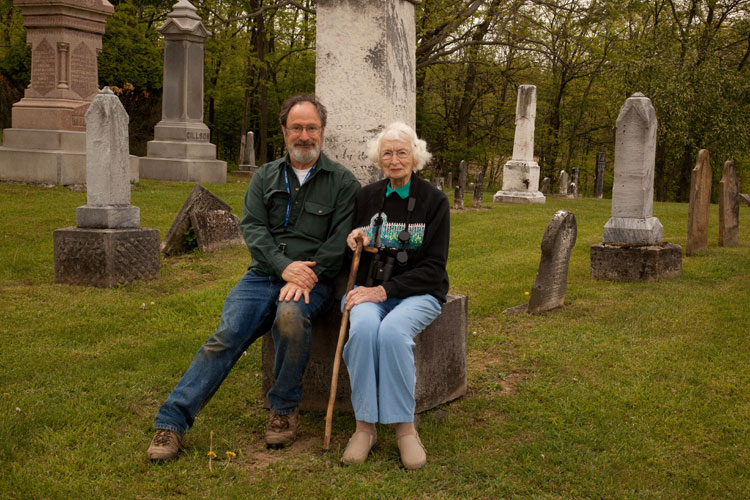 Bob and Trella at Thew Cemetery, Caledonia, Marion County, Ohio. Cemetery headstones and bases
are especially lichen-rich substrates. In their excellent identifcation
manual, Macrolichens of Ohio,
Ray Showman and Don Flenniken report that the following species are
associated with this habitat: Physcia
adscendens, P. millegrana,
Phaeophyscia spp., Physconia detersa, and Xanthoria
spp. It's possible that all of them are present on that headstone, but
since I only had the following old (1917) and somewhat general field
guide with me, it was hard to tell with certainty.
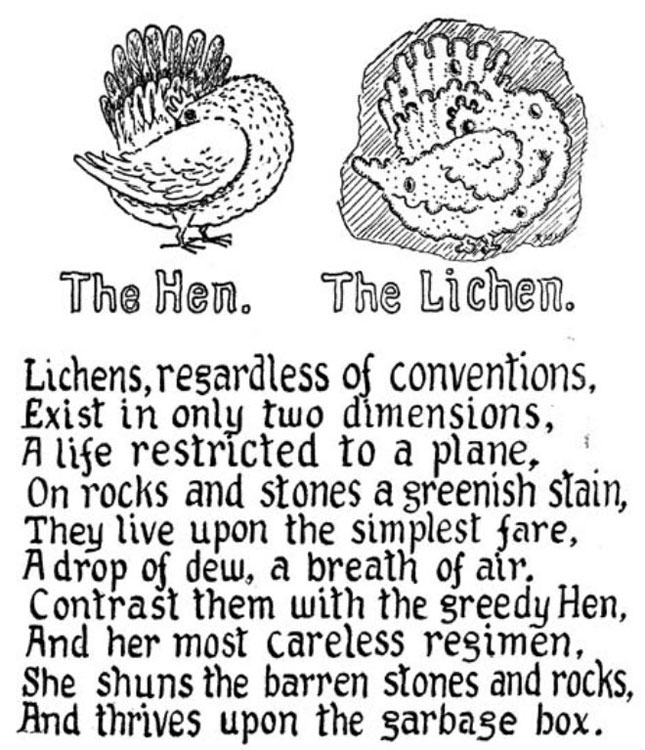 The definitive field guide. How to Tell the Birds from the Flowers by Robert Wood (1917) This is hooded rosette lichen, Physcia adscendens. 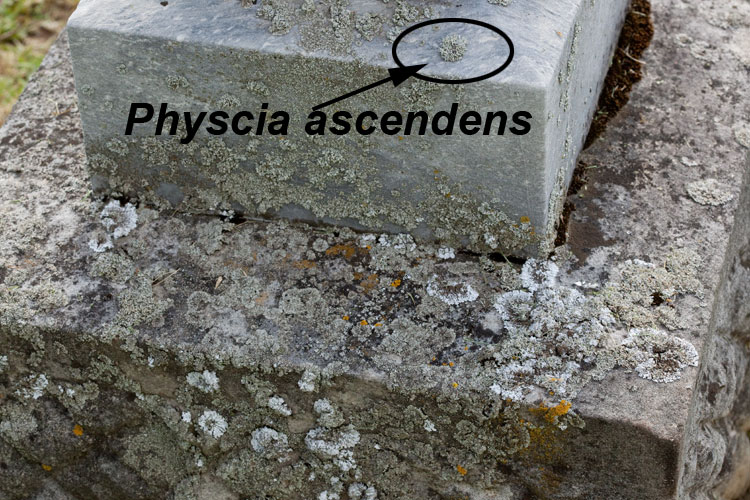 Cemetery headstone and base. May 7, 2010. Caledonia, Marion County, Ohio. Hooded rosette lichen is a medium-sized gray foliose lichen. 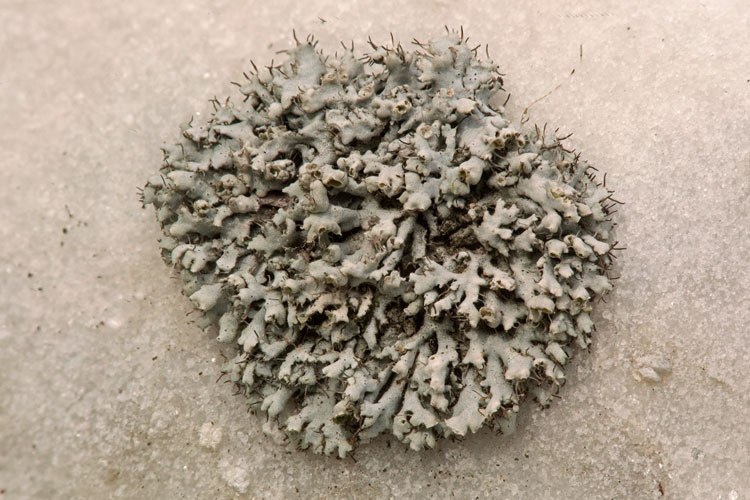 Hooded rosette lichen. May 7, 2010. Caledonia, Marion County, Ohio. This species stands out because its thallus tips are rounded, giving them a paw-shaped aspect. The long white cilia are distinctive as well. 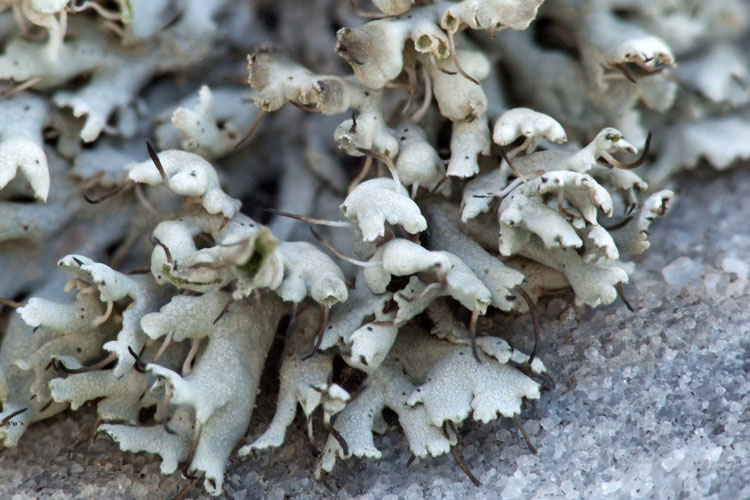 Ciliate, paw-shaped,
thallus tips of hooded rosette lichen.
Perfoliate Bellwort Hocking County, Ohio. May 1, 2010 At this year's annual
excellent as usual Columbus Audubon Society's "Eco-Weekend" at Camp
Oti-Okwa in Hocking County, Ohio, it was a thrill to see perfolate
bellwort, Uvularia perfoliata
(traditionally placed in the Liliaceae, but now considered by the Angiosperm
Phylogeny Group
to be a member of the Colchicacaeae). A few weeks previously I
encountered the more wide-ranging bellwort having perfoliate leaves
--large-flowered bellwort, U.
grandiflora --and thus was on the lookout for this one.
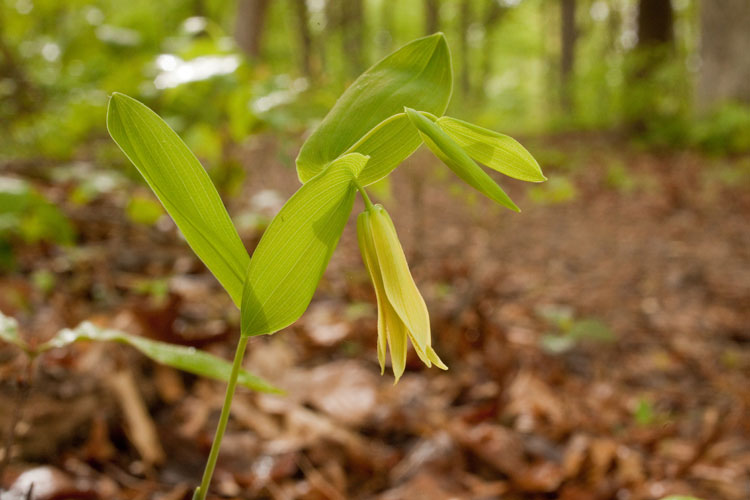 Pefoliate bellwort. May 1, 2010. Hocking County, Ohio. Compared with large-flowered bellwort, perfoliate bellwort is smaller, fewer-flowered, and later-blooming. Moreover, the perianth-segments (i.e., sepals and petals, sometimes called "tepals" in lilies and related plants because they are all colorfully petal-like) are glandular-roughened within. 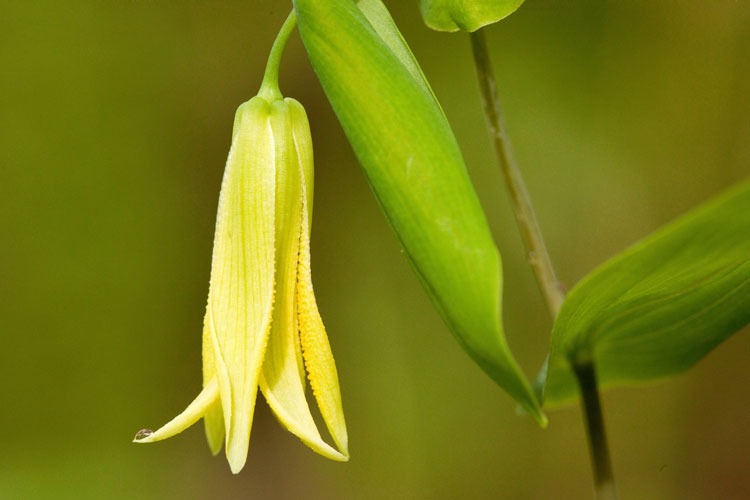 Perfoliate bellwort tepals are glandular-roughened within. May 1, 2010. Hocking County, Ohio. Ulota crispa: That Curly-leaved
Moss Up a Tree
Hocking County, Ohio. May 1, 2010. It was fun to do a workshop on moss identification and ecology at Eco-weekend this year. The rain was great! It moistened the mosses, then it stopped, enabling them to be comfortably seen and photographed. A fairly common and distinctive high-bark dwelling species is "curled bristle moss," Ulota crispa (family Orthotrichaceae). It has an upright "acrocarpous" growth form, i.e., consisting of separate stems that are tipped with sporophytes. In the photo below, several Ulota features stand out. The leaves, even though they are moist (the effect is much more pronounced when dry) are curled and twisted. Note also how the sporophytes have a ruffled hair-do! That's the calyptra --a protective covering (actually part of the maternal gametophyte to which the sporophyte is attached). Moreover, the stalk (seta) of the sporophyte is fairly short, but nonetheless evident. 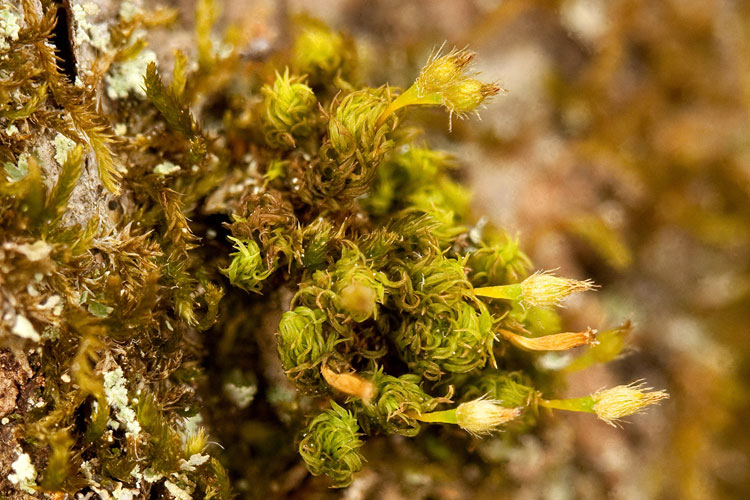 Curled bristle moss (Ulota crispa) ca. 6 ft. high on bark. May 1, 2010. To correctly identify Ulota, it is important to
distinguish it from another tufted high-bark epiphyte genus, Orthotrichum. For comparison,
here's an Orthotrichum seen
mid-March on a hardwood tree in Delaware County, Ohio. Note the Orthotrichum
leaves are straight (not curled). also, the sporophyte stalks (setae)
are short (concealed by the leaves), and their calyptrae are smooth,
not hairy.
|
